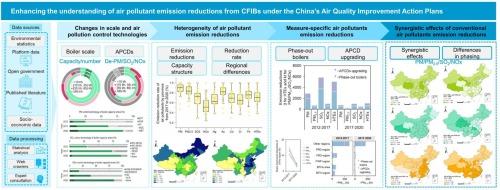加强对《中国清洁空气行动计划》下燃煤工业锅炉大气污染物减排情况的了解
IF 11.3
1区 环境科学与生态学
Q1 ENGINEERING, ENVIRONMENTAL
引用次数: 0
摘要
燃煤工业锅炉(CFIBs)是中国清洁空气计划的重点领域。本研究首先在建立涵盖主要空气污染物种类的最新排放清单的基础上,详细分析了2012 - 2020年实施的两项《清洁空气计划》对中国外资企业空气污染物排放的影响。具体而言,我们分析了大气污染物减排的时空异质性,量化了措施特定的减排,并进一步研究了2012年、2017年和2020年基年对有害微量元素(HTEs)的协同效应。结果表明:2012- 2020年,全国PM、M2.5、SO2、NOx和HTEs (Hg、As、Cd、Cr和Pb的总和)的减排量分别为3678.8 kt、942.0 kt、6672.5 kt、1446.1 kt和5981.7 t,其中2012-2017年减排量最大(66.4-90.5%)。华东、东北和中南是大气污染物减排最有利的区域,对大气污染物减排的贡献率在80.1% ~ 86.9%之间。淘汰锅炉措施导致2012年至2017年期间空气污染物排放量减少最多,占整个期间的58.7-66.3%,而2017-2020年期间空气污染控制设备的升级削弱了其贡献。NOx对HTEs的协同效应弱于PM、PM2.5和SO2,交叉弹性系数最低,且协同效应程度也呈现阶段性异质性。这些发现可以为减少主要部门污染物排放的空气污染控制政策的有效性提供新的见解。本文章由计算机程序翻译,如有差异,请以英文原文为准。

Enhancing the understanding of air pollutant emission reductions from coal-fired industrial boilers under the China’s Clean Air Action Plans
Coal-fired industrial boilers (CFIBs) constitute a priority area of the China’s Clean Air Plans. This study first detailed the effects of two Clean Air Plans implemented during 2012 to 2020 on the air pollutant emissions of Chinese CFIBs based on the establishment of an up-to-date emission inventory covering primary air pollutant species. Specifically, we analysed the spatiotemporal heterogeneity of air pollutant reductions, quantified the measure-specific emission reductions, and further investigated the synergistic effects for hazardous trace elements (HTEs) in the base years 2012, 2017 and 2020. Results showed that national emission reductions in PM, M2.5, SO2, NOx, and HTEs (sum of Hg, As, Cd, Cr, and Pb) were 3678.8 kt, 942.0 kt, 6672.5 kt, 1446.1 kt, and 5981.7 t from 2012 to 2020, respectively, with the largest reductions occurred in the period 2012-2017 (66.4–90.5%). East China, Northeast China, and South-Central China were the most beneficial regions to achieve emission reductions of air pollutants, and their share of the contribution to emission reductions ranged from 80.1% to 86.9%. The measure of phase-out boilers resulted in the highest reductions in air pollutant emissions from 2012 to 2017 with the share of 58.7–66.3% over the entire period, while its contribution was weakened by the upgrading of air pollution control devices during 2017-2020. The synergistic effect of NOx on HTEs was weaker than that of PM, PM2.5, and SO2 with the lowest cross-elasticity coefficient, and the degree of synergistic effects also exhibited stage-specific heterogeneity. The findings could provide new insights into the effectiveness of air pollution control policies in reducing pollutant emissions in major sectors.
求助全文
通过发布文献求助,成功后即可免费获取论文全文。
去求助
来源期刊

Journal of Hazardous Materials
工程技术-工程:环境
CiteScore
25.40
自引率
5.90%
发文量
3059
审稿时长
58 days
期刊介绍:
The Journal of Hazardous Materials serves as a global platform for promoting cutting-edge research in the field of Environmental Science and Engineering. Our publication features a wide range of articles, including full-length research papers, review articles, and perspectives, with the aim of enhancing our understanding of the dangers and risks associated with various materials concerning public health and the environment. It is important to note that the term "environmental contaminants" refers specifically to substances that pose hazardous effects through contamination, while excluding those that do not have such impacts on the environment or human health. Moreover, we emphasize the distinction between wastes and hazardous materials in order to provide further clarity on the scope of the journal. We have a keen interest in exploring specific compounds and microbial agents that have adverse effects on the environment.
 求助内容:
求助内容: 应助结果提醒方式:
应助结果提醒方式:


